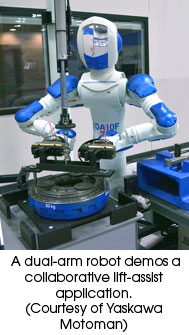A cobot or co-robot (from collaborative robot) is a robot intended to physically interact with humans in a shared workspace.[3] This is in contrast with other robots, designed to operate autonomously or with limited guidance, which is what most industrial robots were up until the decade
No area of industrial robotics has attracted more fanfare than human-robot collaboration. You can’t deny the compelling nature of collaborative robots. They have an innate ability to both fascinate and empower us humans.

With the hype come misconceptions. We will try to dispel these myths, while tackling the growing debate over safety. We’ll also explore the latest developments in this domain and see how researchers on two continents are helping to shape our factories of the future.
A lot of big manufacturers are considering collaborative robots and starting to look at automation in different ways,” says Samuel Bouchard, President of Robotiq, a manufacturer of adaptive grippers for collaborative robots in Lévis, Quebec, Canada. “Traditionally, they would want to automate a specific area in their plant, so they would get an integrator in place to automate that part of the process. It was a top-down engineering approach.”
“That still exists for complex automation applications, but now with collaborative robots, there’s also a new tactic,” says Bouchard. “Many large manufacturers are looking at a bottom-up approach, where they want to approve a collaborative robot tool and then make it available for anybody in the plant to use on demand for simple, stand-alone operations. That’s a very different approach.”

The robot is equipped with mechanical systems and drive technology designed for industrial operation. This makes it possible to automate delicate and complex automation tasks in a manner in which the use of robots was previously inconceivable. The LBR iiwa is also the first robot to have safe torque sensors in every axis. Hence, its high-performance collision detection capabilities and integrated joint torque sensors make the LBR iiwa ideal for delicate joining processes and the use of simple tools. Furthermore, its lightweight nature, multiple axes, and streamlined design make it perfectly suited to confined installation situations and enables very easy integration into pre-existing production systems.
Most importantly, they differ in the technology each robot uses to achieve collaborative operation and the safety mechanisms required to occupy this sometimes fenceless collaborative workspace. Not all collaborative robots are cage-free.
“When we’re talking about collaborative robots, we’re talking about more than just power and force limiting applications, more than just Baxter and Universal,” says Pat Davison, RIA’s Director of Standards Development in Ann Arbor, Michigan.
Other robots in the collaborative arena use power and force limiting. Plus, many traditional robots that aren’t power and force limited can still work in human collaborative operations with the use of functional safety units and safety-rated sensors.
Addressing the needs of small to medium-sized enterprises, the LBR also has a teaching by demonstration feature. The program structure is programmed offline with the waypoints left blank, so that even an operator with no programming knowledge can guide the robot to the desired positions and teach those points. This helps with small-batch runs or the large product variety typical of SMEs. The robot programming is also Java-based for ease of use and openness.
MIT’s Computer Science and Artificial Intelligence Laboratory (CSAIL) – Professor Julie Shah – “Our current research is in manufacturing and how we can integrate robots to work with people on factory floors to build commercial airplanes, cars and consumer electronics,” says Shah. “The true opportunity lies in the non-value-added tasks. This includes movement of materials, set-up, placement, and configuring parts so that a person has less work to do or fewer movements to make. Much of that work can be done by robotics today. But a large proportion of the work is still manual and composed of these non-value-added tasks.”
